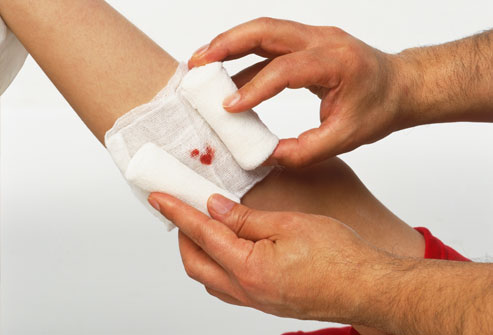
Cuts and burns are common occurrences in our daily lives. Yet, how many of us know the correct way to deal with them? The Manipal Health Digest is here to teach you what to do the next time you end up with burnt hand or a bleeding knee .
It is yet another busy day in college. In the middle of your mechanical workshop, you slowly slip into the world of daydreams. You start thinking about that girl you’ve been crushing on for a week and how to ask her out. But before you know it, you feel a searing pain in your left thumb and you find yourself in a mini-bloodbath. Panic strikes. That dream date remains a dream and the humble saw in your hand catches you red-handed, literally.
A lazy, humdrum Sunday suddenly brings out the Nigella Lawson in you. Why settle for the inedible mess food when you can bring out the MasterChef in you? Little did you realize that the task would also bring out your inner klutz! One careless swish of your hand and the water you were professionally boiling for Maggi splashes on your hand. All you are left with is a red, swollen hand along with the shattered dream of enjoying Maggi. As you take your throbbing hand to the trauma center, you vow to never try cooking again!
Cuts and burns are the most common medical emergencies in our daily lives. Be it a small thorn prick or the deep gash of a knife, they always manage to make us panic, even if we know how to deal with them. There are several wrong ways to manage wounds which people have mastered. In some villages, a common belief is that cow dung is an effective solution to treat a wound. It is indeed an effective solution, to kill the person! Cow dung is a thriving ground for several disease causing bacteria, especially tetanus. It can cause infections, loss of the finger and many other avoidable consequences. Application of chillies to the wound is another misguided belief. And we can only imagine how much that would hurt!
Minor cuts and scrapes do not warrant a visit to the Emergency Triage. With the right knowledge and skill, anyone can easily prevent excessive blood loss or infection after any injury. Here are a few simple steps you need to follow:
1. Wash your hands. With a lot of water. You don’t want to touch an open wound with dirty, grimy fingers, trust us.
2. Stop the bleeding. Minor cuts and scrapes usually stop bleeding on their own. Many people tend to use saliva to stop bleeding (a concept highly misused in romantic movies) but it is advisable to refrain from this. Although known for its anti-bacterial and anti-coagulant properties, human saliva contains a wide variety of bacteria that are usually harmless in the mouth but can cause significant infection if introduced deep within an open wound.
Apply minor pressure to the wound. That should do the trick!
Tourniquets (tight bandages) are thought to be used in case of massive bleeding but only with a lot of caution! Improper techniques, prolonged tying time and inadequate facilities can cause loss of the limb! So do not try this.
3. Clean the wound with water (preferably). Cold water in cases of burns and regular, clean water for anything else. Dettol or Savlon can be used for cuts. And yes, alcohol (read: Old Monk) works too.
4. Apply an antibiotic. Apply a thin layer of an antibiotic cream or ointment (Neosporin, Soframycin). For burns, Burnol is the popular solution.
5. Cover the wound. A Band-Aid or a sterile gauze can be used to cover the wound. Minor cuts may be left uncovered. After the wound has healed enough to make infection unlikely, you can leave it uncovered, as exposure to the air will speed healing.
6. Get a tetanus shot. Clostridium tetani is a type of bacteria that is found everywhere. They are tiny spores that mainly exist in the soil. A popular misconception is that tetanus lives in rust and hence, any contact with rusty objects can cause tetanus! In reality, they enter the body through any break in the skin. It can be your garden variety papercut which doesn’t need treatment. Or it can be a deep and dirty wound that will need medical attention. The take home message is that if you haven’t received a tetanus booster shot in the past 5 years and the wound is really gross, then you should most probably get a tetanus shot.
Wounds come in all shapes and sizes but the basic principles of management remain the same: keep calm, wash your hands and clean the wound.
After these simple steps, you can go back to that daydream or you can be brave enough to venture into the kitchen again!
Leave a Reply
You must be logged in to post a comment.